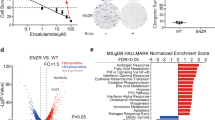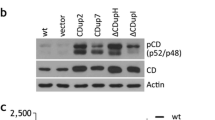Abstract
Global cleavage of cellular proteins by activated caspases is a hallmark of apoptosis, which causes biochemical collapse of the cell. Recent studies suggest that, rather than completely destroying a protein, caspase cleavage can confer novel characteristics or functions. In this respect, the post-caspase role of Bcl-2 family proteins remains uncharacterized. Here, we showed that Mcl-1, a pro-survival member of the Bcl-2 family, was cleaved by caspase-3 in non-small cell lung cancer (NSCLC) cells undergoing chemotherapeutic agent-triggered apoptosis. Caspase cleavage partially impaired the anti-apoptotic activity of Mcl-1 by reducing its mitochondrial localization and impeding its association with the permeability transition pore-forming protein Bak. However, the stability of cleaved Mcl-1 was markedly enhanced because it was more refractory to ubiquitination-dependent proteasomal degradation, thereby improving cell viability to a greater extent than full-length Mcl-1 when transiently expressed in NSCLC cells. These findings shed new light on the role of Mcl-1 in apoptosis and suggest potential novel targets for optimizing the tumoricidal capacity of chemotherapy.






Similar content being viewed by others
Abbreviations
- Mcl-1:
-
Myeloid cell leukemia 1
- BH:
-
Bcl-2 homology
- Bax:
-
Bcl-2-associated protein X
- NSCLC:
-
Non-small cell lung cancer
- PT:
-
Permeability transition
- PARP:
-
Poly ADP-ribose polymerase
- CHX:
-
Cyclohexane
- CCK-8:
-
Cell Counting Kit-8
- PI:
-
Propidium iodide
References
Chabner BA, Roberts TG Jr (2005) Chemotherapy and the war on cancer. Nat Rev Cancer 5:65–72
Fennell DA, Summers Y, Cadranel J, Benepal T, Christoph DC, Lal R, Das M, Maxwell F, Visseren-Grul C, Ferry D (2016) Cisplatin in the modern era: the backbone of first-line chemotherapy for non-small cell lung cancer. Cancer Treat Rev 44:42–50
Fulda S, Debatin KM (2006) Extrinsic versus intrinsic apoptosis pathways in anticancer chemotherapy. Oncogene 25:4798–4811
Olaussen KA, Postel-Vinay S (2016) Predictors of chemotherapy efficacy in non-small cell lung cancer: a challenging landscape. Ann Oncol 27:2004–2016
Pommier Y, Sordet O, Antony S, Hayward RL, Kohn KW (2004) Apoptosis defects and chemotherapy resistance: molecular interaction maps and networks. Oncogene 23:2934–2949
Kontos CK, Christodoulou MI, Scorilas A (2014) Apoptosis-related BCL2-family members: key players in chemotherapy. Anti-Cancer Agent Med Chem 14:353–374
Vela L, Marzo I (2015) Bcl-2 family of proteins as drug targets for cancer chemotherapy: the long way of BH3 mimetics from bench to bedside. Curr Opin Pharmacol 23:74–81
Hata AN, Engelman JA, Faber AC (2015) The BCL2 family: key mediators of the apoptotic response to targeted anticancer therapeutics. Cancer Disc 5:475–487
Thomas LW, Lam C, Edwards SW (2010) Mcl-1; the molecular regulation of protein function. FEBS Lett 584:2981–2989
Ertel F, Nguyen M, Roulston A, Shore GC (2013) Programming cancer cells for high expression levels of Mcl1. EMBO Rep 14:328–336
Belmar J, Fesik SW (2015) Small molecule Mcl-1 inhibitors for the treatment of cancer. Pharmacol Ther 145:76–84
Quinn BA, Dash R, Azab B, Sarkar S, Das SK, Kumar S, Oyesanya RA, Dasgupta S, Dent P, Grant S et al (2011) Targeting Mcl-1 for the therapy of cancer. Expert Opin Investig Drugs 20:1397–1411
Kazi A, Sun J, Doi K, Sung SS, Takahashi Y, Yin H, Rodriguez JM, Becerril J, Berndt N, Hamilton AD et al (2011) The BH3 alpha-helical mimic BH3-M6 disrupts Bcl-X(L), Bcl-2, and MCL-1 protein-protein interactions with Bax, Bak, Bad, or Bim and induces apoptosis in a Bax- and Bim-dependent manner. J Biol Chem 286:9382–9392
Adams JM, Cory S (2007) The Bcl-2 apoptotic switch in cancer development and therapy. Oncogene 26:1324–1337
Akgul C, Moulding DA, White MR, Edwards SW (2000) In vivo localisation and stability of human Mcl-1 using green fluorescent protein (GFP) fusion proteins. FEBS Lett 478:72–76
Germain M, Duronio V (2007) The N terminus of the anti-apoptotic BCL-2 homologue MCL-1 regulates its localization and function. J Biol Chem 282:32233–32242
Morciano G, Giorgi C, Balestra D, Marchi S, Perrone D, Pinotti M, Pinton P (2016) Mcl-1 involvement in mitochondrial dynamics is associated with apoptotic cell death. Mol Biol Cell 27:20–34
Kim JH, Sim SH, Ha HJ, Ko JJ, Lee K, Bae J (2009) MCL-1ES, a novel variant of MCL-1, associates with MCL-1L and induces mitochondrial cell death. FEBS Lett 583:2758–2764
Inuzuka H, Fukushima H, Shaik S, Liu P, Lau AW, Wei W (2011) Mcl-1 ubiquitination and destruction. Oncotarget 2:239–244
Herrant M, Jacquel A, Marchetti S, Belhacene N, Colosetti P, Luciano F, Auberger P (2004) Cleavage of Mcl-1 by caspases impaired its ability to counteract Bim-induced apoptosis. Oncogene 23:7863–7873
Gyorffy B, Surowiak P, Budczies J, Lanczky A (2013). Online survival analysis software to assess the prognostic value of biomarkers using transcriptomic data in non-small-cell lung cancer. PLoS ONE 8:e82241
Friberg A, Vigil D, Zhao B, Daniels RN, Burke JP, Garcia-Barrantes PM, Camper D, Chauder BA, Lee T, Olejniczak ET et al (2013) Discovery of potent myeloid cell leukemia 1 (Mcl-1) inhibitors using fragment-based methods and structure-based design. J Med Chem 56:15–30
Yang CY, Wang S (2012) Analysis of Flexibility and hotspots in Bcl-xL and Mcl-1 proteins for the design of selective small-molecule inhibitors. ACS Med Chem Lett 3:308–312
Webb B, Sali A (2014) Comparative protein structure modeling using MODELLER. Curr Protoc Bioinform 47(56):1–32
Pronk S, Pall S, Schulz R, Larsson P, Bjelkmar P, Apostolov R, Shirts MR, Smith JC, Kasson PM, van der Spoel D et al (2013) GROMACS 4.5: a high-throughput and highly parallel open source molecular simulation toolkit. Bioinformatics 29:845–854
Brooks BR, Brooks CL 3rd, Mackerell AD Jr, Nilsson L, Petrella RJ, Roux B, Won Y, Archontis G, Bartels C, Boresch S et al (2009) CHARMM: the biomolecular simulation program. J Comput Chem 30:1545–1614
Chen R, Li L, Weng Z (2003) ZDOCK: an initial-stage protein-docking algorithm. Proteins 52:80–87
Li L, Chen R, Weng Z (2003) RDOCK: refinement of rigid-body protein docking predictions. Proteins 53:693–707
Yang Z, Wu F, Yuan X, Zhang L, Zhang S (2016) Novel binding patterns between ganoderic acids and neuraminidase: Insights from docking, molecular dynamics and MM/PBSA studies. J Mol Graphics Model 65:27–34
Elkholi R, Renault TT, Serasinghe MN, Chipuk JE (2014) Putting the pieces together: how is the mitochondrial pathway of apoptosis regulated in cancer and chemotherapy? Cancer Metabol 2:16
Soldani C, Scovassi AI (2002) Poly(ADP-ribose) polymerase-1 cleavage during apoptosis: an update. Apoptosis 7:321–328
Rogers JM, Oleinikovas V, Shammas SL, Wong CT, De Sancho D, Baker CM, Clarke J (2014) Interplay between partner and ligand facilitates the folding and binding of an intrinsically disordered protein. Proc Natl Acad Sci USA 111:15420–15425
Cao X, Yap JL, Newell-Rogers MK, Peddaboina C, Jiang W, Papaconstantinou HT, Jupitor D, Rai A, Jung KY, Tubin RP et al (2013) The novel BH3 alpha-helix mimetic JY-1–106 induces apoptosis in a subset of cancer cells (lung cancer, colon cancer and mesothelioma) by disrupting Bcl-xL and Mcl-1 protein-protein interactions with Bak. Mol Cancer 12:42
Hengartner MO (2000) The biochemistry of apoptosis. Nature 407:770–776
Parrish AB, Freel CD, Kornbluth S (2013) Cellular mechanisms controlling caspase activation and function. Cold Spring Harbor Perspect Biol 5:a008672
Liu X, He Y, Li F, Huang Q, Kato TA, Hall RP, Li CY (2015) Caspase-3 promotes genetic instability and carcinogenesis. Mol Cell 58:284–296
Huang Q, Li F, Liu X, Li W, Shi W, Liu FF, O’Sullivan B, He Z, Peng Y, Tan AC et al (2011) Caspase 3-mediated stimulation of tumor cell repopulation during cancer radiotherapy. Nat Med 17:860–866
Reubold TF, Eschenburg S (2012) A molecular view on signal transduction by the apoptosome. Cell Signal 24:1420–1425
Correia C, Lee SH, Meng XW, Vincelette ND, Knorr KL, Ding H, Nowakowski GS, Dai H, Kaufmann SH (2015) Emerging understanding of Bcl-2 biology: implications for neoplastic progression and treatment. Biochim Biophys Acta 1853:1658–1671
Zheng JH, Viacava Follis A, Kriwacki RW, Moldoveanu T (2016) Discoveries and controversies in BCL-2 protein-mediated apoptosis. FEBS J 283:2690–2700
Luna-Vargas MP, Chipuk JE (2016) The deadly landscape of pro-apoptotic BCL-2 proteins in the outer mitochondrial membrane. FEBS J 283:2676–2689
Opferman JT (2016) Attacking cancer’s Achilles heel: antagonism of anti-apoptotic BCL-2 family members. FEBS J 283:2661–2675
Day CL, Smits C, Fan FC, Lee EF, Fairlie WD, Hinds MG (2008) Structure of the BH3 domains from the p53-inducible BH3-only proteins Noxa and Puma in complex with Mcl-1. J Mol Biol 380:958–971
Le Gouill S, Podar K, Harousseau JL, Anderson KC (2004) Mcl-1 regulation and its role in multiple myeloma. Cell Cycle 3:1259–1262
Huang K, Zhang J, O’Neill KL, Gurumurthy CB, Quadros RM, Tu Y, Luo X (2016) Cleavage by caspase 8 and mitochondrial membrane association activate the BH3-only protein bid during TRAIL-induced Apoptosis. J Biol Chem 291:11843–11851
Sarosiek KA, Chonghaile NT, Letai A (2013) Mitochondria: gatekeepers of response to chemotherapy. Trends Cell Biol 23:612–619
Acknowledgements
This work was supported by the National Natural Science Foundation of China (Grant Nos. 81472631 and 31200429).
Author information
Authors and Affiliations
Corresponding authors
Ethics declarations
Conflict of interest
The authors declare no conflicts of interest.
Electronic supplementary material
Below is the link to the electronic supplementary material.
10495_2017_1436_MOESM1_ESM.tif
Supplementary Figure 1. Survival of lung cancer patients (Total) and those receiving routine chemotherapy as grouped by Mcl-1 expression levels. (TIF 98 KB)
10495_2017_1436_MOESM2_ESM.tif
Supplementary Figure 2. Western blot analysis of cells after treatment with CP (20 μmol/L) for the indicated times. (TIF 57 KB)
Rights and permissions
About this article
Cite this article
Wang, T., Yang, Z., Zhang, Y. et al. Caspase cleavage of Mcl-1 impairs its anti-apoptotic activity and proteasomal degradation in non-small lung cancer cells. Apoptosis 23, 54–64 (2018). https://doi.org/10.1007/s10495-017-1436-5
Published:
Issue Date:
DOI: https://doi.org/10.1007/s10495-017-1436-5




